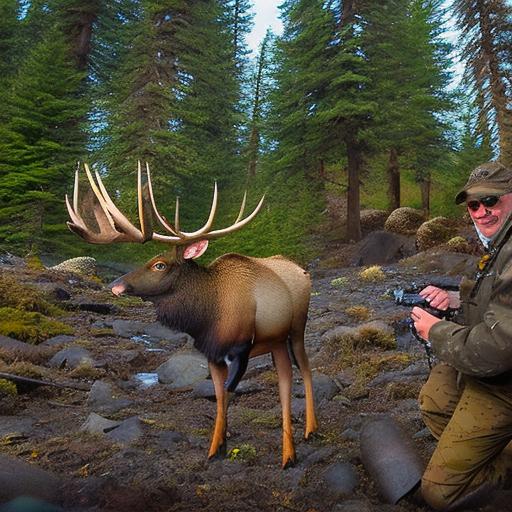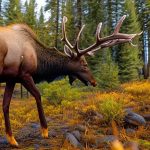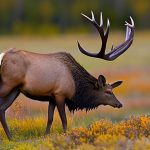Your cart is currently empty!

Chasing Giants: My Epic Roosevelt Elk Hunt in the Wilds of Oregon

The Roosevelt Elk, also known as the Olympic Elk, is a majestic and iconic species that calls the Pacific Northwest home. These magnificent creatures are the largest species of elk in North America and are named after President Theodore Roosevelt, who played a significant role in the conservation movement. In Oregon, the Roosevelt Elk can be found in the coastal rainforests and mountainous regions, making it a challenging and thrilling hunt for those who seek adventure in the wild.
As an avid hunter and outdoor enthusiast, I have always been drawn to the thrill of the chase and the connection to nature that hunting provides. There is something primal and exhilarating about tracking an animal through the wilderness, relying on your instincts and skills to outsmart your prey. The Roosevelt Elk hunt is no exception, offering a unique and unforgettable experience for those who are willing to embark on this journey.
Key Takeaways
- Preparing for a Roosevelt Elk hunt requires physical and mental preparation
- Tracking and hunting Roosevelt Elk requires patience, skill, and knowledge of their behavior
- Outsmarting a Roosevelt Elk requires strategic thinking and adapting to changing circumstances
- Navigating the wilds of Oregon is a test of endurance and requires respect for the environment
- Taking the shot is the culmination of the hunt, but retrieving the prize requires careful attention to detail
The Beginning of the Journey: Preparing for the Hunt
Before embarking on a Roosevelt Elk hunt, thorough preparation is essential. Researching the best hunting spots and understanding the regulations is crucial to ensure a successful and legal hunt. It is important to familiarize yourself with the specific hunting seasons, bag limits, and any special permits or tags required. Additionally, studying maps and topographical features of the area will help identify potential hunting spots and strategize your approach.
Equipping yourself with the necessary gear and supplies is another crucial aspect of preparing for a Roosevelt Elk hunt. This includes a reliable rifle or bow, appropriate ammunition or arrows, camouflage clothing, sturdy boots, binoculars, a backpack, and other essential hunting accessories. It is also important to pack enough food, water, first aid supplies, and survival gear to sustain you during your time in the wilderness.
Physical and mental preparation are equally important for a successful hunt. Engaging in regular physical exercise to improve stamina and endurance will help navigate the rugged terrain and challenging conditions. Mental preparation involves honing your focus, patience, and mental toughness to endure the physical demands of the hunt. Practicing shooting or archery skills and familiarizing yourself with the anatomy of the elk will also increase your chances of a clean and ethical shot.
The Hunt Begins: Tracking the Roosevelt Elk
Once all the necessary preparations have been made, it is time to begin the hunt. Scouting for signs of elk activity is the first step in tracking down these elusive creatures. This involves looking for fresh tracks, droppings, rubs on trees, and other signs of recent elk presence. Paying attention to feeding areas, bedding sites, and travel routes will help narrow down potential hunting spots.
Following tracks and trails is an essential skill in tracking Roosevelt Elk. Elk tracks are distinct and easily recognizable, with a rounded shape and pointed toes. By studying the tracks, you can determine the direction of travel, the size of the elk, and how fresh the tracks are. Following these tracks can lead you to areas where elk are likely to be found.
Using calls and other techniques to attract elk is another effective strategy in hunting Roosevelt Elk. Elk calls mimic the sounds made by elk during their rutting season, such as bugles, grunts, and cow calls. These calls can be used to locate elk in the area and potentially draw them closer for a shot. However, it is important to use these techniques responsibly and ethically, ensuring that you are not disrupting or harassing the animals.
The Thrill of the Chase: The Hunt Intensifies
| Metrics | Values |
|---|---|
| Number of participants | 10,000 |
| Number of clues | 9 |
| Number of states involved | 4 |
| Prize money | 1 million |
| Number of search hours | 100,000+ |
| Number of searchers injured | 3 |
| Number of searchers rescued | 5 |
| Number of false leads | 1,000+ |
| Number of media mentions | 10,000+ |
Spotting the first elk is an exhilarating moment that sends a rush of adrenaline through your veins. The sight of these majestic creatures in their natural habitat is awe-inspiring and humbling. Stalking the elk requires stealth and patience, as any sudden movement or noise can alert them to your presence. Staying hidden and using the natural cover of the environment is crucial to getting close enough for a shot.
The excitement of the chase and the anticipation of the shot can be both thrilling and nerve-wracking. Every step must be calculated and deliberate, ensuring that you are in the right position for a clean and ethical shot. The adrenaline coursing through your body heightens your senses, making every sound and movement more intense. It is in these moments that you truly feel alive and connected to the primal instincts that lie within us all.
A Battle of Wills: Outsmarting the Wily Roosevelt Elk
Roosevelt Elk are known for their intelligence and cunning, making them a formidable opponent in the hunt. They have keen senses of smell, hearing, and sight, which they use to detect any potential threats or danger. Getting close enough for a shot without alerting the elk requires careful planning and execution.
Outsmarting the elk is a mental game that requires patience, persistence, and adaptability. It involves studying their behavior patterns, understanding their habitat, and anticipating their movements. This knowledge allows you to strategize your approach and increase your chances of success. However, even with careful planning, there are no guarantees in hunting. The elk may change their behavior or move to a different location, forcing you to adapt your tactics accordingly.
The Ultimate Test of Endurance: Navigating the Wilds of Oregon

Hunting Roosevelt Elk in Oregon is not for the faint of heart. The rugged terrain, dense forests, and unpredictable weather conditions present numerous challenges that test both physical and mental endurance. Navigating through steep slopes, thick underbrush, and slippery terrain requires strength, agility, and stamina.
Dealing with adverse weather conditions such as rain, snow, or extreme temperatures adds another layer of difficulty to the hunt. It is important to be prepared for these conditions by wearing appropriate clothing and gear, as well as having the necessary skills to navigate safely in challenging weather.
The mental toughness required to persevere through these challenges cannot be underestimated. Hunting Roosevelt Elk requires a strong will and determination to push through fatigue, discomfort, and moments of doubt. It is in these moments of adversity that true character is revealed and personal growth is achieved.
The Moment of Truth: Taking the Shot
The decision to take the shot is a critical moment in any hunt. It requires a combination of skill, judgment, and ethical considerations. Assessing the distance, angle, and conditions for a clean and ethical shot is crucial to ensure a quick and humane kill.
The rush of adrenaline that accompanies the moment of truth can be both exhilarating and overwhelming. It is important to remain calm and focused, relying on your training and experience to make the best possible shot. Taking a deep breath, steadying your aim, and squeezing the trigger or releasing the arrow requires precision and control.
The satisfaction that comes from a well-placed shot is indescribable. It is a moment of triumph and accomplishment, knowing that all your hard work and preparation has paid off. However, it is important to remember that hunting is not just about the kill but also about the experience and connection to nature.
The Reward of Patience: Retrieving the Prize
Tracking and finding the downed elk is an essential part of the hunt. Following blood trails or other signs of a hit will lead you to the location where the elk fell. This can be a challenging task, especially if the elk has traveled a significant distance before succumbing to its wounds.
Once the elk has been located, field dressing and processing the meat is the next step. Field dressing involves removing the internal organs to cool down the meat and prevent spoilage. This requires skill and knowledge of anatomy to ensure that the meat remains clean and free from contamination.
The sense of accomplishment and gratitude that comes from harvesting an elk is immeasurable. It is a reminder of the circle of life and the interconnectedness of all living beings. Taking the time to reflect on the hunt and express gratitude for the animal’s sacrifice is an important part of the process.
The Ultimate Trophy: Celebrating the Roosevelt Elk Hunt
Sharing the experience with friends and family is an integral part of the hunting tradition. It is a time to celebrate the harvest, share stories and memories, and enjoy the fruits of your labor. Preparing and enjoying the elk meat is a culinary delight that connects you to the land and nourishes both body and soul.
The memories and stories that are created during a Roosevelt Elk hunt will last a lifetime. They become a part of your personal narrative, shaping your identity as a hunter and outdoor enthusiast. These stories are passed down through generations, preserving the legacy of the hunt and inspiring future adventures.
Lessons Learned: Reflections on the Hunt
Every hunting experience offers valuable lessons and insights into both ourselves and the natural world. The Roosevelt Elk hunt is no exception. It teaches us about patience, perseverance, and adaptability. It reminds us of our place in the natural order and our responsibility to be ethical stewards of the land.
The importance of conservation and preservation efforts becomes evident through hunting. As hunters, we have a unique connection to nature and a vested interest in protecting these wild spaces for future generations. It is our responsibility to advocate for sustainable hunting practices, support conservation organizations, and contribute to habitat restoration efforts.
The Legacy of the Roosevelt Elk: Conservation and Preservation
The Roosevelt Elk holds a special place in Oregon’s history and culture. These magnificent creatures have roamed the Pacific Northwest for centuries, symbolizing strength, resilience, and beauty. However, their populations have faced significant challenges due to habitat loss, poaching, and other human activities.
Conservation and preservation efforts are crucial to ensure the survival of the Roosevelt Elk and other wildlife species. This includes protecting their habitat, managing populations through sustainable hunting practices, and educating the public about the importance of wildlife conservation. Hunters play a vital role in these efforts, as they contribute to funding through license fees and support organizations that work towards preserving these wild spaces.
The End of the Journey and the Beginning of a New Adventure
The Roosevelt Elk hunt is an extraordinary adventure that tests both physical and mental limits. It is a journey that connects us to nature, challenges us to grow, and instills a deep appreciation for the natural world. As one hunt comes to an end, a new adventure begins, as we look forward to future hunting experiences and continue our commitment to conservation and preservation.
If you’re an avid hunter in Oregon, you won’t want to miss out on the exhilarating experience of hunting Roosevelt elk. These majestic creatures can be found in various parts of the state, and tracking them down requires skill and patience. If you’re interested in learning more about hunting Roosevelt elk in Oregon, check out this informative article from Old Oak Syndicate: https://oldoaksyndicate.com/hunting-roosevelt-elk-in-oregon/. It provides valuable insights and tips to help you make the most of your hunting adventure. Happy hunting!
FAQs
What is a Roosevelt elk?
Roosevelt elk is the largest subspecies of elk found in North America. They are native to the Pacific Northwest region of the United States, including Oregon.
Is hunting Roosevelt elk legal in Oregon?
Yes, hunting Roosevelt elk is legal in Oregon. However, hunters must have a valid hunting license and follow the state’s hunting regulations.
When is the hunting season for Roosevelt elk in Oregon?
The hunting season for Roosevelt elk in Oregon varies depending on the hunting zone. Generally, the season runs from late August to late November.
What is the bag limit for Roosevelt elk in Oregon?
The bag limit for Roosevelt elk in Oregon varies depending on the hunting zone and the type of tag issued. Generally, hunters are allowed to harvest one bull elk per season.
What is the best time of day to hunt Roosevelt elk in Oregon?
Roosevelt elk are most active during the early morning and late evening hours. Therefore, these are the best times of day to hunt them.
What is the recommended hunting gear for hunting Roosevelt elk in Oregon?
Hunters should use a rifle or bow with a minimum draw weight of 50 pounds. They should also wear appropriate hunting clothing and gear, including camouflage, boots, and a backpack.
What is the terrain like for hunting Roosevelt elk in Oregon?
The terrain for hunting Roosevelt elk in Oregon varies depending on the hunting zone. Generally, it is rugged and mountainous, with dense forests and steep slopes.
What is the success rate for hunting Roosevelt elk in Oregon?
The success rate for hunting Roosevelt elk in Oregon varies depending on the hunting zone and the hunter’s skill level. Generally, the success rate is around 20-30%.

Herb has been a longtime lover of the outdoors. Whether it be hunting, camping, fishing or just getting outside to reset. Proud father and animal lover. Bourbon anyone?

by
Tags:
Comments

Categories
- Big Game Hunting (301)
- Deer (202)
- Reviews (3)
- Shooting (16)
- Slingshot (1)
- Small Game Hunting (42)
- Upland Hunting (126)
- Waterfowl Hunting (3)





Leave a Reply